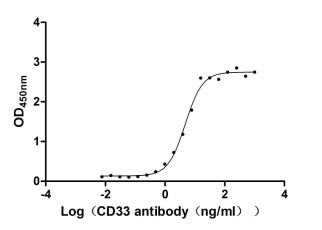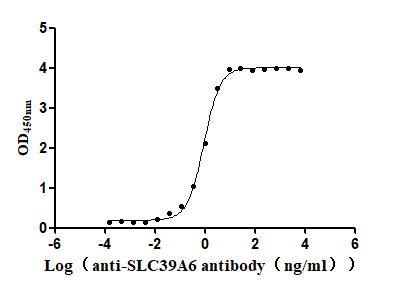Recombinant Human Membrane frizzled-related protein (MFRP), partial
-
货号:CSB-YP013758HU
-
规格:
-
来源:Yeast
-
其他:
-
货号:CSB-EP013758HU
-
规格:
-
来源:E.coli
-
其他:
-
货号:CSB-EP013758HU-B
-
规格:
-
来源:E.coli
-
共轭:Avi-tag Biotinylated
E. coli biotin ligase (BirA) is highly specific in covalently attaching biotin to the 15 amino acid AviTag peptide. This recombinant protein was biotinylated in vivo by AviTag-BirA technology, which method is BriA catalyzes amide linkage between the biotin and the specific lysine of the AviTag.
-
其他:
-
货号:CSB-BP013758HU
-
规格:
-
来源:Baculovirus
-
其他:
-
货号:CSB-MP013758HU
-
规格:
-
来源:Mammalian cell
-
其他:
产品详情
-
纯度:>85% (SDS-PAGE)
-
基因名:MFRP
-
Uniprot No.:
-
别名:MFRPMembrane frizzled-related protein; Membrane-type frizzled-related protein
-
种属:Homo sapiens (Human)
-
蛋白长度:Partial
-
蛋白标签:Tag type will be determined during the manufacturing process.
The tag type will be determined during production process. If you have specified tag type, please tell us and we will develop the specified tag preferentially. -
产品提供形式:Lyophilized powder
Note: We will preferentially ship the format that we have in stock, however, if you have any special requirement for the format, please remark your requirement when placing the order, we will prepare according to your demand. -
复溶:We recommend that this vial be briefly centrifuged prior to opening to bring the contents to the bottom. Please reconstitute protein in deionized sterile water to a concentration of 0.1-1.0 mg/mL.We recommend to add 5-50% of glycerol (final concentration) and aliquot for long-term storage at -20℃/-80℃. Our default final concentration of glycerol is 50%. Customers could use it as reference.
-
储存条件:Store at -20°C/-80°C upon receipt, aliquoting is necessary for mutiple use. Avoid repeated freeze-thaw cycles.
-
保质期:The shelf life is related to many factors, storage state, buffer ingredients, storage temperature and the stability of the protein itself.
Generally, the shelf life of liquid form is 6 months at -20°C/-80°C. The shelf life of lyophilized form is 12 months at -20°C/-80°C. -
货期:Delivery time may differ from different purchasing way or location, please kindly consult your local distributors for specific delivery time.Note: All of our proteins are default shipped with normal blue ice packs, if you request to ship with dry ice, please communicate with us in advance and extra fees will be charged.
-
注意事项:Repeated freezing and thawing is not recommended. Store working aliquots at 4°C for up to one week.
-
Datasheet :Please contact us to get it.
靶点详情
-
功能:May play a role in eye development.
-
基因功能参考文献:
- We report the MFRP-related ocular phenotype in three siblings with glycogen storage disease type 1b. Molecular genetic studies identified novel mutations in the MFRP and SLC37A4 genes. PMID: 28511025
- The current study expands our knowledge of the mutation spectrum of MFRP and its associated phenotypes. To our knowledge, this is the first report of MFRP mutations in a Chinese cohort. PMID: 26583794
- Among five single nucleotide polymorphism(SNP)s tested, only MFRP rs3814762 and heat shock protein (HSP)70 rs1043618 show nominal association with primary angle closure. PMID: 23378726
- nanophthalmos and high hyperopia but without electrophysiological evidence of retinal dystrophy has also been associated with MFRP mutations. PMID: 23143909
- Corneal diameter decreases with decreasing axial length, suggesting posterior microphthalmos and nanophthalmos represent a spectrum of high hyperopia rather than distinct phenotypes. In the Saudi population PRSS56 mutations are the major cause. PMID: 23127749
- Homozygous autosomal recessive retinitis pigmentosa-causing mutations have been found in three Indian families. These included a single base deletion in MFRP. PMID: 22605927
- MFRP gene shows tendency to be associated with primary angle closure glaucoma in both the Australian and Nepalese cohorts. PMID: 22933837
- Posterior microphthalmos can be caused by nonsense compound heterozygous mutations in the MFRP gene. PMID: 22565643
- In both previous reports of PMPRS, mutations in membrane type frizzled-related protein (MFRP) gene (located at 11q23) was demonstrated to be present PMID: 21416382
- Three novel MFRP mutations that expand the phenotypic data available on patients with MFRP mutations, are reported. PMID: 20361016
- Extreme hyperopia (Nanophthalmos) is the result of null mutations in MFRP. PMID: 15976030
- Mutation of the membrane-type frizzled-related protein gene is associated with inherited retinal degenerations PMID: 16352475
- Defects in MFRP could be responsible for syndromic forms of microphthalmos/retinal degeneration. This gene is necessary for photoreceptor maintenance. PMID: 17167404
- These results indicate that the MFRP gene may not play a role in regulating ocular axial length in these phenotypes. PMID: 18334955
- Patients without MFRP gene function exhibit no correction of refractive error during childhood, which suggests that this gene is essential for emmetropization, a complex process by which vision regulates axial growth of the eye. PMID: 18363166
- The novel frameshift mutation identified in the family described here validates MFRP as the gene responsible for this particular disease, which characteristically involves structures located at the posterior segment of the eye. PMID: 18554571
- These results do not support a significant role for CHX10 or MFRP mutations in primary angle closure glaucoma. PMID: 18648522
- Significant associations between angle-closure glaucoma and sequence variants in the MFRP gene, was analyzed. PMID: 18781223
- MFRP is less likely to play a major role in physiologic high hyperopia. PMID: 19169412
- This is the first demonstration of compound heterozygosity for MFRP mutations. PMID: 19753314
- Describes the role of CTRP5 in disease, in addition to the bicistronic nature of CTRP5 and MFRP, which is confirmed by RT-PCR. PMID: 12944416
显示更多
收起更多
-
相关疾病:Nanophthalmos 2 (NNO2); Microphthalmia, isolated, 5 (MCOP5)
-
亚细胞定位:Apical cell membrane; Single-pass type II membrane protein.
-
组织特异性:Specifically expressed in brain. Strongly expressed in medulla oblongata and to a lower extent in hippocampus and corpus callosum. Expressed in keratinocytes.
-
数据库链接:
HGNC: 18121
OMIM: 606227
KEGG: hsa:83552
STRING: 9606.ENSP00000456533
UniGene: Hs.632102
Most popular with customers
-
Recombinant Human Myeloid cell surface antigen CD33 (CD33), partial (Active)
Express system: Mammalian cell
Species: Homo sapiens (Human)
-
Recombinant Mouse Prolactin receptor (Prlr), partial (Active)
Express system: Mammalian cell
Species: Mus musculus (Mouse)
-
Recombinant Macaca mulatta Semaphorin-4D isoform 1 (SEMA4D), partial (Active)
Express system: Mammalian cell
Species: Macaca mulatta (Rhesus macaque)
-
Recombinant Human C-C chemokine receptor type 8 (CCR8)-VLPs (Active)
Express system: Mammalian cell
Species: Homo sapiens (Human)
-
Recombinant Macaca fascicularis zymogen granule protein 16 homolog B (ZG16B) (Active)
Express system: Mammalian cell
Species: Macaca fascicularis (Crab-eating macaque) (Cynomolgus monkey)
-
Recombinant Human Carcinoembryonic antigen-related cell adhesion molecule 8(CEACAM8) (Active)
Express system: Mammalian cell
Species: Homo sapiens (Human)
-
Recombinant Macaca fascicularis Transmembrane 4 L6 family member 1 (TM4SF1)-VLPs (Active)
Express system: Mammalian cell
Species: Macaca fascicularis (Crab-eating macaque) (Cynomolgus monkey)
-
Recombinant Macaca fascicularis Zinc transporter ZIP6 isoform X1(SLC39A6),partial (Active)
Express system: Baculovirus
Species: Macaca fascicularis (Crab-eating macaque) (Cynomolgus monkey)




















